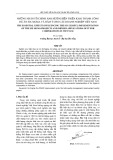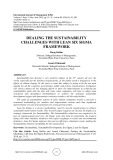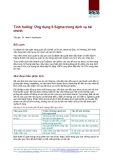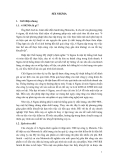
ISSN: 2615-9740
JOURNAL OF TECHNICAL EDUCATION SCIENCE
Ho Chi Minh City University of Technology and Education
Website: https://jte.edu.vn
Email: jte@hcmute.edu.vn
JTE, Volume 19, Special Issue 03, 2024
90
Continuous Improvement of Productivity and Quality with Applying Lean Six
Sigma: A case study
Minh Tai Le*, Hoang Khang Lu , Kieu Thuy Hang Nguyen
Ho Chi Minh City University of Technology and Education, Vietnam
*Corresponding author. Email: tailm@hcmute.edu.vn
ARTICLE INFO
ABSTRACT
Received:
03/05/2024
Any business that wants to compete may need to constantly raise both its
output and quality. An effective and popular approach to achieving
continuous improvement is known as Lean Six Sigma. This paper
demonstrates a successful implementation through a case study in wood
manufacturing. The enhancement greatly benefited from the optimization
of the production process. The seven quality control tools were integrated
into specific systematic steps of the PDCA cycle and DMAIC process,
along with lean technology. As a result, this led to an increase in product
quality and a decrease in manufacturing errors. Customer satisfaction and
market competitiveness have risen as a result. A wood production line's
productivity and quality were both improved, and this case study
demonstrates the positive effects. It could be considered for
implementation in various production or assembly lines in other fields such
as electronic, clothing and furniture assembly lines.
Revised:
04/06/2024
Accepted:
02/07/2024
Published:
28/08/2024
KEYWORDS
Industrial Engineering;
Lean;
Lean Six Sigma;
Improvement;
Wood Company.
Doi: https://doi.org/10.54644/jte.2024.1586
Copyright © JTE. This is an open access article distributed under the terms and conditions of the Creative Commons Attribution-NonCommercial 4.0
International License which permits unrestricted use, distribution, and reproduction in any medium for non-commercial purpose, provided the original work is
properly cited.
1. Introduction
Lean Manufacturing was first used to describe Toyota’s car-making process and has its roots in
Japan. It is considered a pivotal moment in the transition from traditional manufacturing thinking to lean
thinking [1]. These are 6 advantages of lean manufacturing: less process waste, reduced production time,
less rework, cost savings, reduced inventory. Eliminating all types of waste inside the firm is the main
goal of implementing a lean manufacturing system. A lean system comprises two fundamental pillars:
the first being “jidoka” and the second being “just-in-time”. A lean manufacturing system’s main
objective is to produce high-quality goods as quickly and inexpensively as possible [2].
In their study, Rahman et al. [3] demonstrated that the Kanban system can be used to implement lean
production with minimal inventory and reduced costs. The author of this research also implemented the
Kanban system and found that it led to a reduction in operating costs, waste, scrap, and loss, while also
allowing for more flexible workstations and better control of production warehouses.
Another study by Anil S. Badiger et al. [4] explored ways to improve device performance through
the implementation of Kaizen and poka-yoke. This study's objective was to improve productivity and
overall performance, and its findings revealed that OEE rose from 49.9% to 74.68%. This rise in OEE
led to better resource utilization, higher availability, higher product quality, and stronger employee trust
in their work.
Some time ago, professionals who had been utilizing Six Sigma and Lean Manufacturing merged
these approaches, giving rise to what is known as Lean Six Sigma (LSS). A lean culture forms the perfect
basis for the swift and effective incorporation of the Six Sigma quality practices. Moreover, Six Sigma
metrics guide the implementation of Lean Manufacturing practices when they are most suitable.
Additionally, the methods and processes of Six Sigma should be employed to minimize defects in
processes, which is often a critical prerequisite for the success of a lean production project [5]. Lean Six
Sigma, which focuses on continuously improving processes, gained prominence in the 1980s as Toyota
emerged to dominate the US car market. They achieved this by producing cars that were not only less
expensive but also of higher quality than American manufacturers [6]. It can be applied to enhance the

ISSN: 2615-9740
JOURNAL OF TECHNICAL EDUCATION SCIENCE
Ho Chi Minh City University of Technology and Education
Website: https://jte.edu.vn
Email: jte@hcmute.edu.vn
JTE, Volume 19, Special Issue 03, 2024
91
quality management of equipment maintenance. This approach tackles deficiencies and inefficiencies
within the equipment maintenance process, leading to increased efficiency and improved equipment
maintenance quality [7].
Another, Lean Six Sigma focuses on delivering customer satisfaction by providing high-quality
products, on-time delivery, balanced work processes, eliminating waste, efficient work performance,
and easy observation and management. It’s quickly becoming a key driver for many technology-driven,
project-driven organizations. Various approaches to Six Sigma have been adopted to increase the overall
performance of different business areas. Those efforts all contribute to improve the efficiency and
maximizing the value of the Six Sigma method. Six Sigma principles and implementations are more
likely to succeed by continually improving organizational culture [8].
In today's competitive landscape, wood manufacturers face mounting pressure to embrace new
manufacturing practices and management strategies. This shift is driven by the need to reduce
production costs, streamline delivery times, and improve overall product quality to remain competitive
in an increasingly globalized market [9]. Within the wood products industry, the pursuit of continuous
improvement underscores an ongoing commitment to enhancing both quality and productivity [10]-[11].
Over the past decade, Lean Six Sigma (LSS) has found adoption in numerous companies as they
restructure their manufacturing processes. LSS revolves around monitoring production yields, reducing
costs, and shortening cycle times [12]. J. Guerrero et al. [13] applied LSS implementation in a small
furniture company, revealing potential benefits, including a 25% reduction in defects, a 13% decrease
in waste, and a 14% increase in sales productivity in the first year.
The use of Lean Six Sigma tools and techniques led to significant improvements in productivity and
product quality at a furniture manufacturing company, based on the methodology's accomplishments
and efficacy [14]. Leading B2B supplier of premium wooden furniture, the company's headquarters are
situated on a 30-hectare campus in Binh Duong, Vietnam. The company boasts an indoor manufacturing
area of over 10 hectares, complete with a swimming pool, kindergarten, and after-school center for its
employees' families. With over 750 skilled employees and over 28 years of experience, the company
distributes over 120 containers of premium furniture per month to over 20 countries worldwide, with
the US, Japan, and Korea being their main markets. The author of this report optimized multiple areas
of the company's production process by implementing Lean Six Sigma concepts. The main goals were
to lower production costs, raise output productivity, and enhance product quality. A strong basis is
established for the development and broader adoption of these methods in the furniture production
industry, as well as their potential expansion into other related industries, by utilizing the extensive
techniques and tools of Lean Six Sigma, as described in this article.
2. Literature review and methods
2.1. Lean six sigma
Lean Six Sigma is a management methodology that combines Lean and Six Sigma, emerging as a
highly effective approach to improving processes and reducing costs in manufacturing companies. This
study integrates the seven quality control tools into the PDCA cycle and DMAIC process to optimize
the production process [15]-[16]. Lean approach focuses on minimizing waste and lead time, optimizing
production flow, and increasing productivity, all of which are highly desirable outcomes for
manufacturers. Companies can use Lean technologies to detect and reduce waste in their manufacturing
processes, resulting in considerable cost savings and increased efficiency. Six Sigma, on the other hand,
is a fantastic technique for increasing product quality and minimizing defects. Six Sigma assists
businesses in eliminating defects and lowering repair costs, resulting in higher customer satisfaction and
revenues. However, implementing Lean Six Sigma methods in a business is not easy, and quick success
is not assured. It takes a clear commitment from senior leadership to make decisions based on a long-
term perspective, even if it means sacrificing short-term financial goals.
2.2. Six Sigma DMAIC methodology
To attain the maximum level of Six Sigma, 3.4 faults per million, Motorola created a five-stage
process known as the 'DMAIC Model'. The five steps are described below: define the problem or
opportunity for improvement; measure process performance and identify the key inputs; analyze the

ISSN: 2615-9740
JOURNAL OF TECHNICAL EDUCATION SCIENCE
Ho Chi Minh City University of Technology and Education
Website: https://jte.edu.vn
Email: jte@hcmute.edu.vn
JTE, Volume 19, Special Issue 03, 2024
92
data to determine the root cause of the defects (in this step, fishbone diagram, 5-WHYS, ...); improve
the process by eliminating defects using kanban cards, check sheets, etc.; control the new process and
continuously monitor performance.
3. Results and Discussion
3.1. Productivity Improvement
The Dayna chair product line has 8 continuous packaging stages that are carried out on 2 conveyor
belts arranged at right angles to each other as shown in Figure 1.
Figure 1. Dayna Side Chair packaging process
Table 1. Cycle time of each step before improvement
Step/Time (s)
Assemble seat
and cushion
Balance
legs
Blow off
dust, label
Wrap seat
backrest
Wrap chair
legs
Pair chairs
Make box
Pack and
seal box
T01
31.72
51.31
10.34
56.74
92.2
26.21
46.23
78.67
T02
27.37
54.07
12.78
52.53
100.49
30.18
62.67
67.05
T03
30
46.78
11.36
47.61
105.73
36.89
50.56
77.34
T04
27.38
54.11
12.05
52.66
92.12
37.56
41.12
54.06
T05
27.65
41.59
10.11
64.3
96.86
35.12
46.35
54.48
T06
29.09
38.33
13.89
63.4
90.28
27.31
44.93
62.67
T07
32.21
48.12
11.54
50.12
110.41
28.47
55.01
56.12
T08
38.29
49.13
10.15
57.25
89.25
28.32
49.45
62.78
T09
37.02
44.86
11.4
49.15
90.86
30.15
48.89
61.45
T10
32.7
41.67
9.86
48.53
97.89
27.25
47.71
65.34
Average Time
31
47
11
54
97
31
49
64
Take-time
57
57
57
57
57
57
57
57
Tmax
97
97
97
97
97
97
97
97
Figure 2. The Cycle Time chart for each stage before improvement

ISSN: 2615-9740
JOURNAL OF TECHNICAL EDUCATION SCIENCE
Ho Chi Minh City University of Technology and Education
Website: https://jte.edu.vn
Email: jte@hcmute.edu.vn
JTE, Volume 19, Special Issue 03, 2024
93
𝑇𝑎𝑘𝑡 𝑡𝑖𝑚𝑒 = 𝑊𝑜𝑟𝑘𝑖𝑛𝑔 𝑡𝑖𝑚𝑒 1 𝑑𝑎𝑦
𝑅𝑒𝑞𝑢𝑒𝑠𝑡 𝑎 𝑑𝑎𝑦 𝑜𝑟𝑑𝑒𝑟 =11400
200 =57 (𝑠𝑒𝑐𝑜𝑛𝑑)
The author identified five areas for improvement based on data and observations: establishing a
support device for the foam-cutting process, arranging material shelves and work tables during the
packaging stage, removing the bottleneck of the bottle necktie during the leg wrapping operation, and
ensuring consistent operation and material positioning during the box wrapping process as shown in
Figure 2.
3.1.1. Remove the bottleneck of bottle necktie removal in the leg wrapping process
Table 2. Status before and after improvement of the leg wrapping process.
BEFORE
AFTER
Issue
Image
Result
Image
The finished products remain stagnant
on the conveyor, causing it to stop for
troubleshooting.
The number of finished products has
decreased.
Workers have to run around to perform
tasks and often experience shoulder
fatigue by the end of their shift.
Workers no longer need to run to
perform tasks, resulting in faster and
more comfortable operations.
The coordination between two workers
is ineffective.
Workers perform tasks more accurately
and do not waste materials.
Workers doing other people's tasks lead
to uneven work performance.
Everyone has improved their work
performance.
Before the change, the author watched and documented the ineffective packaging procedure in the
inefficient area. There were excessively many pointless steps and inefficient movements, which at this
point created a bottleneck. After identifying the reasons and non-value-added operations, the author
offered and implemented remedies to eliminate them, improving process efficiency and avoiding
wasteful resource waste.
Table 3. The result after improving the leg wrapping process.
Content
Before
After
Effective
Cycle time (s)
97
47
Reduced 51.55%
WIP
6
1
Reduced 83.33%
3.1.2. Standardize the operation and material placement position at the box wrapping process
The workers' packaging procedure includes a number of wasteful steps. Furthermore, material
positioning is inefficient, wasting time and reducing packaging output. The author observed and altered
the operation, redefining the location of materials to make it more sensible. The results indicated that
the packing process’s cycle time fell from 64 seconds to 48 seconds (a 25% reduction), and it was less
than the Takt time.
3.1.3. Design a support device for the foam-cutting method
Foam is one of the necessary materials in the packaging process, used for packing tables, chairs,
sofas, etc. The process of preparing foam specifications is an important and necessary step in the
packaging process. However, the current situation shows that this process requires two people to work
together, the speed of producing foam sheets according to demand is not fast, and the workers can easily
get tired when performing a large amount of work.

ISSN: 2615-9740
JOURNAL OF TECHNICAL EDUCATION SCIENCE
Ho Chi Minh City University of Technology and Education
Website: https://jte.edu.vn
Email: jte@hcmute.edu.vn
JTE, Volume 19, Special Issue 03, 2024
94
Figure 3. Design ideas of cutting tool for foam
Figure 4. The worker is implementing a new the foam-
cutting method
From those identified issues, the author proposed a new foam cutting plan that involves using a
cutting tool for foam. This tool has a simple structure and is made from readily available materials from
the company (Figure 3).To assure the tool's safety and stability during use, the author calculated and
evaluated its durability with Inventor simulation software. The tool was then manufactured and directly
integrated into the production process (Figure 4). After a period of implementation, the author obtained
the following results:
Table 4. Results of implementing a new the foam-cutting method
Content
Before
After
Effective
Workers
2
1
Reduced 50%
Time (s) of cutting 100 foarms (1050*1000)
80
50
Reduced 37.35%
Tolerance (mm)
±8
±6
Reduced 28.57%
3.1.4. Set up and arrange material shelves, and work tables at the packaging stage
The author applied the 5S method to organize and arrange tools and materials on shelves and
workstations in a visual manner, following the principles of easy retrieval, minimal movement, and
straightforward management. This facilitated the packaging process, and eliminated waste and
inefficiency during operations. The author proposed and implemented a labeling system for material
shelves to improve worker awareness and facilitate management (Figure 5).
Figure 5. Packaging material shelf before (a, b) and after (c, d) improvement.
3.1.5. Design the layout for placing finished products, defective products, quality inspection, and repair
of defective products
Because the packaging area was not clearly divided into zones for outgoing products, finished goods
placement, and material storage, products were spilling into walkways and other areas, making it
difficult to supply packaging materials, equipment, and raw materials, resulting in delays and hampered
access (Figure 6).













![Tối ưu hóa hiệu suất hệ thống: Bài thuyết trình [Chuẩn nhất]](https://cdn.tailieu.vn/images/document/thumbnail/2025/20251107/hiepdz2703@gmail.com/135x160/35941762488193.jpg)




![Bài giảng Quản trị chất lượng trong công nghiệp thực phẩm [chuẩn nhất]](https://cdn.tailieu.vn/images/document/thumbnail/2025/20250805/vijiraiya/135x160/637_bai-giang-quan-tri-chat-luong-trong-cong-nghiep-thuc-pham.jpg)

![Đề cương bài giảng Kỹ năng hoạt động công nghiệp [mới nhất]](https://cdn.tailieu.vn/images/document/thumbnail/2025/20250715/kimphuong1001/135x160/76971752564028.jpg)


![Bài giảng Kỹ thuật điều độ trong sản xuất và dịch vụ [mới nhất]](https://cdn.tailieu.vn/images/document/thumbnail/2025/20250630/dcbaor/135x160/13121751251866.jpg)


